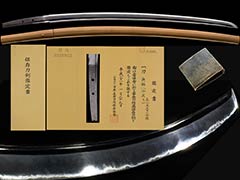
小反り刀Kozori Katana
No.746447刀 備州長船 小反り 南北朝時代相伝備前名品 二尺五寸一分Katana Bisyu Osafune Kozori Nanbokucho periode Wouden Bizen a masterpiece 76.2cm
ご成約Sold
- 極めKiwame
- 小反りKozori
- 登録証Registration
- 熊本県 Kumamoto 昭和26年10月1日 10/1/26(Showa)
- 時代Period
- 南北朝時代Nanbokucho period
- 法量Size
-
刃長 76.2cm (二尺五寸一分) 反り 2.0cm
元幅 3.1cm 先幅 1.9cm 元重 0.61cm 鎬厚 0.67cm 先重 0.43cm 鋒長 3.4cm 茎長 19.2cm 重量 753gHachou 76.2cm (二尺五寸一分) Sori 2.0cm
Moto-Haba 3.1cm Saki-Haba 1.9cm Moto-Kasane 0.61cm Shinogi-Thikess 0.67cm Saki-Kasane 0.43cm Kissaki-Chou 3.4cm Nakago-Chou 19.2cm Weight 753g - 国Country
- 備前Bizen
- 姿Shape
- 鎬造、庵棟、身幅広く、反り深く、腰反りつき、中鋒延びる。Shinogidukuri, Iorimune, Wide Mihaba, Deep Sori, Koshizori-tsuki, Chu-Kissaki extended.
- 鍛Kitae
- 板目肌に、杢目交じり、地沸微塵につき、地景よく入り、乱れ映り鮮やかにたつ。Itamehada, Mixed Mokume, Jinie entered finely and Chikei entered well, Vividly Midare-Utsuri-tatsu.
- 刃文Hamon
- 小のたれに、互の目・丁子刃交じり、足入り、小沸よくつき、金筋・砂流しかかり、匂口明るい。Small-Notare, Gunome, Mixed Choujiba, Ashi enter, Small-Nie entered well, Kinsuji and Sunagashi-kakari, Nioikuchi is bright.
- 帽子Boushi
- 乱れ込んで小丸。Midarekonde-Komaru
- 茎Nakago
- 大磨上、先切、鑢目筋違、目釘孔二。Oh-suriage, Sakikiri, Yasurimesujikai, Mekugiana are two(2)
- ハバキHabaki
- 銀着一重。Single layer silver jacket.
- 彫物Carving
- 表裏に棒樋を掻き流す。Scrape Bohi on both sides.
- 説明Drscription
- 小反派は、長船正系以外の南北朝時代に活躍した長船鍛冶を指し、主な刀工としては、秀光、政光 、盛光の兄師光などがいる。本作は、元は三尺近い太刀で、磨上ながら尚二尺五寸の長さを残し、身幅広く、腰反りつき、鋒延びる南北朝時代の迫力ある姿で、杢目がよく交じる板目肌に、地景よく入り、乱れ映り鮮やかにたつ地鉄に、のたれて、互の目・丁子刃など交じり、沸が良くつき、匂口明るく、金筋・砂流しかかる相伝備前の名品である。The Kozori school refers to the Osafune blacksmiths who were active during the Nanbokucho period and were not part of the official Osafune lineage, and the main swordsmiths included Hidemitsu, Masamitsu, and Morimitsu's older brother Moromitsu.
This sword was originally a long sword Tachi of nearly 3 shaku, Although it is Suriage, it still has a length of 2 shaku 5 Sun, and has wide Mihaba. Koshizori-tsuki, With the impressive appearance of the Nanbokucho era, when Kissaki was extended, Mixed Itamehada in Mokume, Chikei entered well, Midare-Utsuri vividly in Jitetsu, Notarete, Gunome, Mixed Choujiba, Nie entered well, Nioikuchi is bright, Kinsuji, Sunagashi-kakaru is a masterpiece of the Bizen period.


